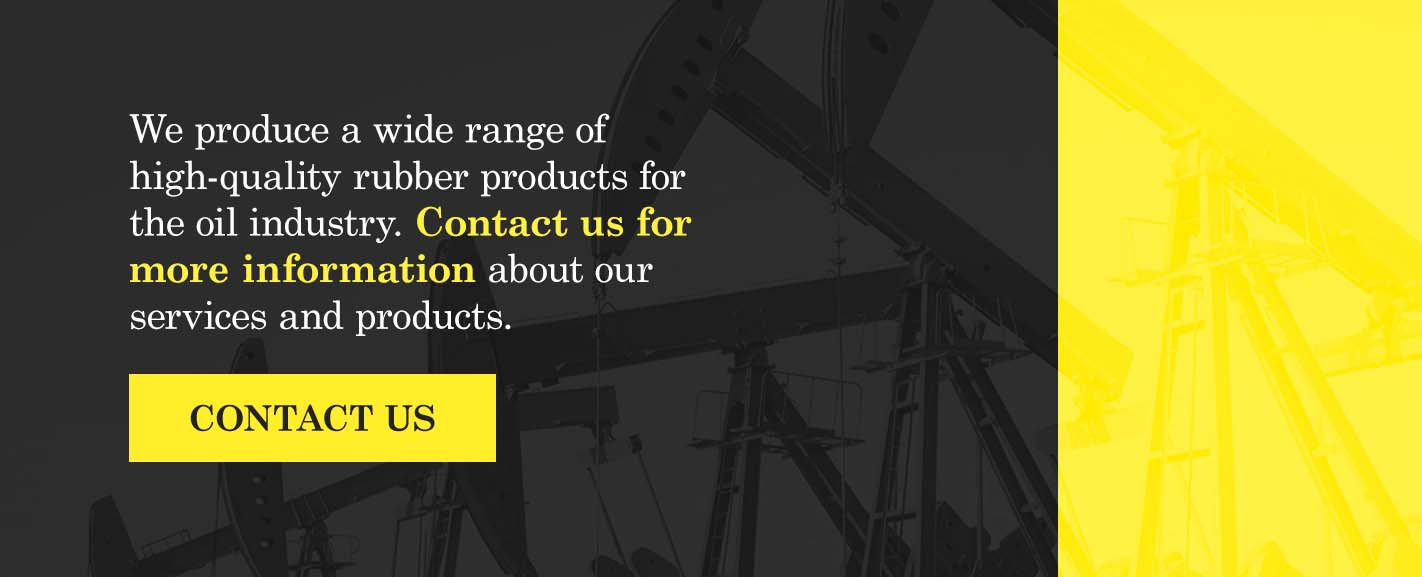Well Servicing 101
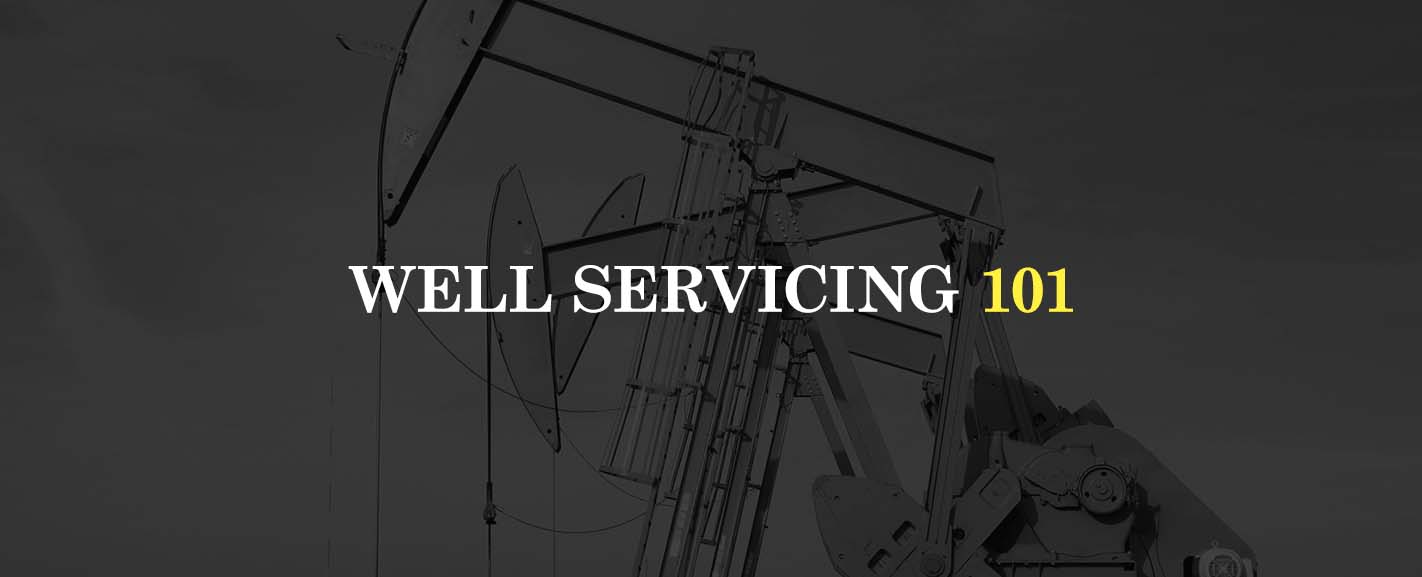
Well servicing is an essential part of operating an oil or gas well. Servicing encompasses the tasks done during the rest of the life of the well after drilling. Therefore, it is essential to keep up with these maintenance activities. Regular servicing can prevent problems before major disruptions occur. Understanding the basics of well maintenance and well services will give you a better appreciation for these tasks during the well's production life.
Table of Contents
- What Is Well Servicing?
- Types of Work That Fall Under the Category of Well Servicing
- Ways to Optimize Servicing
- Well Servicing Basics
- The Importance of Well Servicing
- Explore Our Other Posts at Global Elastomeric Products, Inc. to Get More Insights Into the Oil Industry
What Is Well Servicing?
Well servicing encompasses all the work on an oil well after drilling until capping. Because servicing includes maintenance and repairs on the well's structure or components, a separate team headed by the well services supervisor oversees these tasks. All tasks involved in well servicing ensure that the oil continues to flow and the well components function as expected.
Types of Work That Fall Under the Category of Well Servicing
Well servicing involves many types of work. Sometimes the well can continue to operate while it undergoes servicing. In some instances, shutting down production can result in better flow following the changes, making the workover effort worth the temporary stoppage. Since each well's situation differs, and various well servicing tasks will be needed at different times.
Well Work
Well work, also known as well interventions, includes any repairs or changes needed to improve the well's operation. This type of service includes light and heavy interventions.
Light interventions typically fall to the well service crew. These types of well work do not require the well to stop pumping. Instead, crews may conduct operations such as using wireline or coiled tubing to prevent future blockages. In some cases, light interventions may include collecting data from the bottom of the well or adjusting pumps and valves downwell.
The other type of well work is heavy intervention, which also goes by the term workover.
Workover
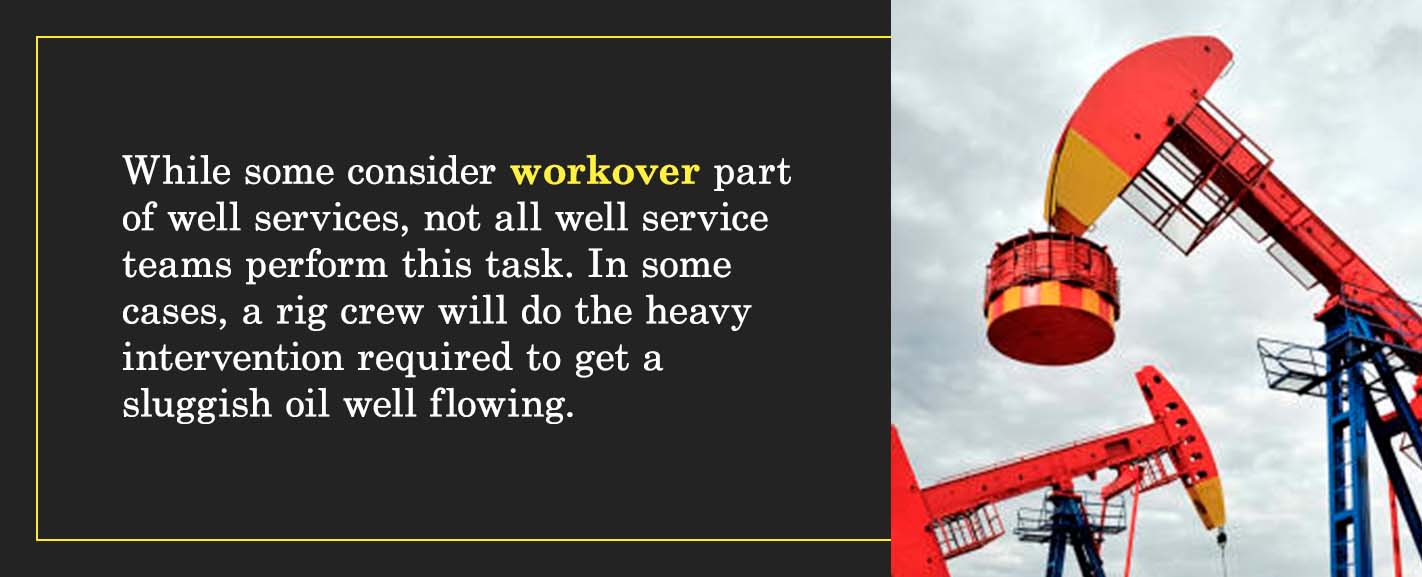
While some consider workover part of well services, not all well service teams perform this task. In some cases, a rig crew will do the heavy intervention required to get a sluggish oil well flowing.
This task requires the team to fill the well with kill weight mud to stop the flow pressure. They will then take apart the well's completion components and replace worn parts. Other times, they may need to make more significant changes to allow the well to adapt to integrating sand and water production or other major alterations.
Maintenance and Repairs
Generally, maintenance and repairs are synonymous with well servicing. Regular inspections of the well find problems in their early stages. Repairs can fix those issues before they disrupt the oil well's productivity.
Inspections
Inspections include a wide variety of tests on wells to determine their productivity and integrity. Some tests are preemptively conducted to determine the health of the well. Examples of these include daily production and the oil-to-gas ratio. Regulatory agencies may require an oil-to-gas ratio test and receive a copy of the results. Other types of tests on the health of the well may include visual exams to look for corrosion, poor welding or signs of wear. Radiography tests use x-rays to see into the equipment to check for component integrity.Thermography tests can find leaks in a pipeline or insulation by measuring the temperature differences between the pipeline and the surrounding area.
Other tests help to find the cause of a potential problem. For instance, a barrel test can identify which well had a drop in production if the daily production for several wells decreased.
Ways to Optimize Servicing
There are several ways to optimize well servicing. Keeping good records and maintaining frequent inspections are two methods of improving the service that you get from the well services team.
You must ensure you have everything ready for the well services team to know the operational status of the well, if problems have occurred and how often you've had maintenance or repair done.
Keep Accurate Records
Information about the oil well's service history and operation will help the service team do their jobs better. Maintain records on the well's production, changes made to influence production levels and what those changes were.
Also track data on the well's casing specifications. Casing information should include the diameter and height of the casing, how far the perforations are from the wellhead and the bottom of the well plus the sizes of the perforations. Similar data about the tubing in the well is also essential.
Well servicing teams will need size information about the well's casing and tubing. This data will allow them to choose the correct equipment to make repairs or improvements to the well. Providing the service team with accurate information will reduce delays in their work.
Conduct Frequent Inspections
Frequent inspections can also help optimize the service team's efforts. Specific states have guidelines dictating frequency and types of inspections for wells. While these inspections ensure compliance with state requirements for safe well operation, they should not replace regular well testing to look for potential issues.
For instance, run a daily production test on the same day monthly. This test requires standard operating conditions. A significant change in the results from this test may trigger more specific examinations of the well.
Other tests are best done following the heavy intervention or other servicing on the well. After you've made significant changes to the well, isolating the well and shutting it in to build pressure ensures results from oil-to-gas ratio tests are accurate.
Well Servicing Basics
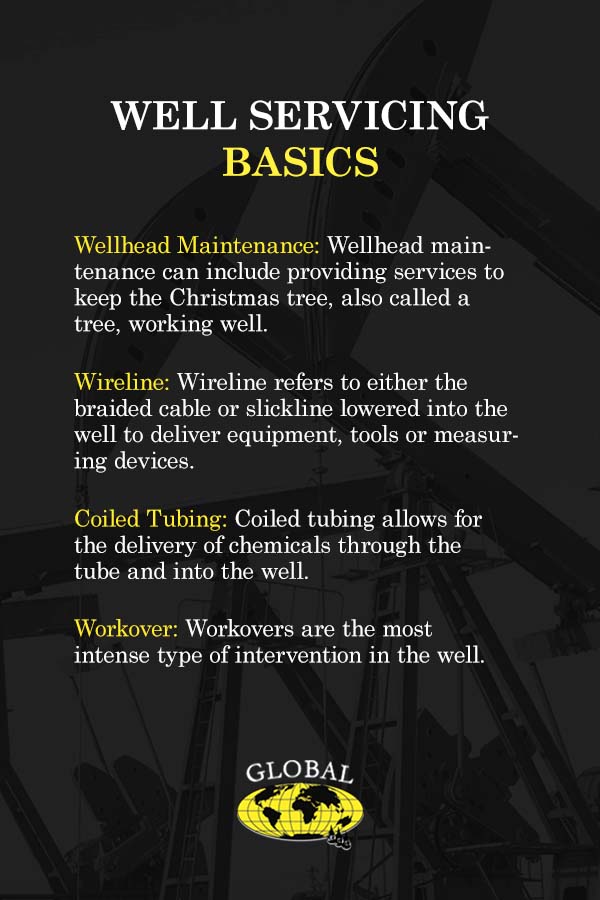
Well servicing keeps the well operating at its peak. Some tasks assist in taking measurements of the well by placing sensors or making adjustments to equipment. Other types of services help to improve pressure in wells that experience reduced production. All services aid in keeping the well productive for as long as possible.
Wellhead Maintenance
Wellhead maintenance can include providing services to keep the Christmas tree, also called a tree, working well. The Christmas tree is an arrangement of valves that regulates the flow from the oil well.
Sometimes annual maintenance includes only checking the function and integrity of these components while adding grease to keep moving parts lubed. In older wells, maintenance may require the crew to test the well's pressure and check that the tree valves work as expected.
Wireline
Wireline refers to either the braided cable or slickline lowered into the well to deliver equipment, tools or measuring devices. The tools lowered into the well assist with multiple tasks. These may include getting information about pore sizes, finding casing collars, examining rock properties, measuring the pressure of hydrocarbon formations or collecting samples.
Some wireline cables may have coreless designs, especially braided lines. However, slickline or braided cables can also include electric cable cores, which can collect and log information about the well.
Coiled Tubing
Coiled tubing allows for the delivery of chemicals through the tube and into the well. The name of this tubing comes from the wound coil in which it is stored. Before use, though, technicians unfurl the coil and drop the tubing down the well.
While this tubing provides some drilling assistance, it also helps with well servicing. During well production, coiled tubing can deliver chemicals to help remove sand from the well. In instances when specific chemicals, such as acids, must go onto spots along the sides of the well, coiled tubing can deliver those, too.
Workover
Workovers are the most intense type of intervention in the well. This type of service requires pulling many components of the well out and making major corrections to the well to improve or restore flow. For instance, crews will remove the wellhead to improve access to the well. They must also use dense kill weight mud to weigh down the well and stop the flow. The use of a rig and rig crew are common with workovers to handle the heavy lifting of the wellhead and other components.
Minor workovers will replace damaged, worn or leaking parts inside the well. However, some workovers allow the well to accommodate sand or water to increase the well's pressure and improve production.
Sometimes, instead of using kill weight mud to stop the oil flow, the crew will opt for snubbing equipment to stop the oil flow by pushing tubing against the well's pressure. Unlike kill weight mud, this option does not have the chance of permanently stopping the flow of the well.
After workovers, well services may include intensive testing to verify that the well is flowing again and production has resumed. Ideally, the production levels would be higher than before the improvements made to the well during workover.
The Importance of Well Servicing
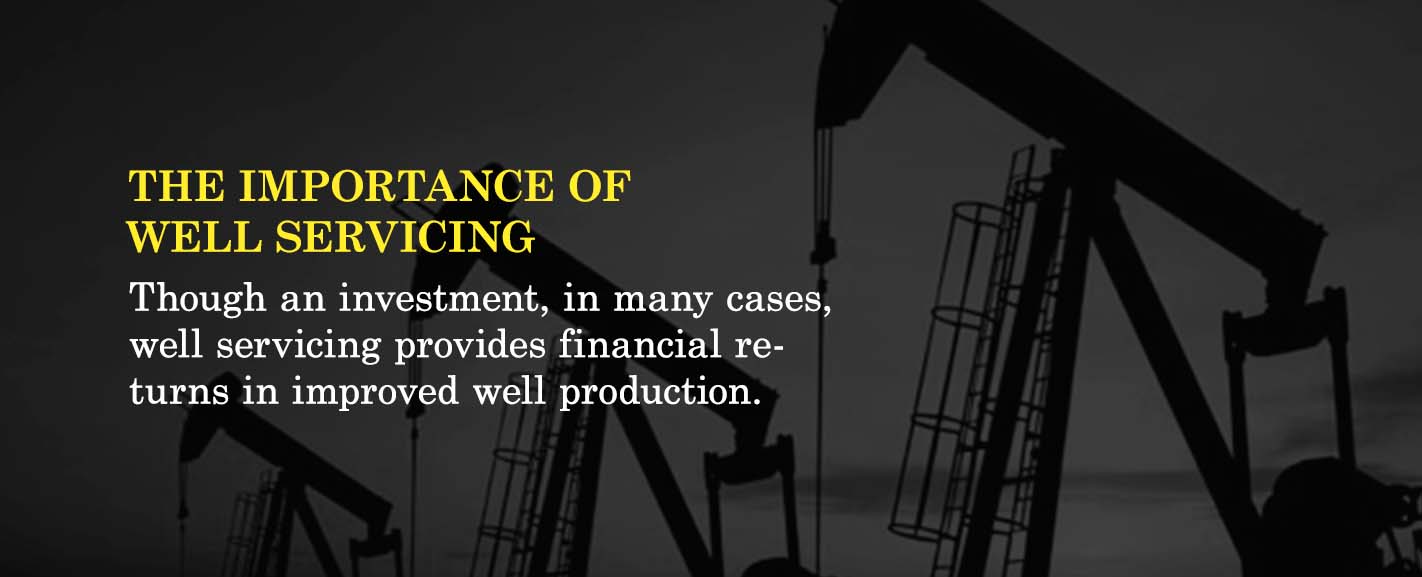
Well servicing is important for finding and fixing minor problems before they become major. Plus, through servicing, well operators can boost their productivity by making changes to the well components. Though an investment, in many cases, well servicing provides financial returns in improved well production. In many instances, these returns can exceed the investment cost, providing a positive return on investment in the servicing.
Well Servicing Finds Issues Before They Worsen
When conducting tests of the health and function of a well between mandated inspections, well services teams can find minor issues before they become major. For instance, regular testing each month of the daily production can determine if a well has a major change volume that could indicate a growing problem.
Part of identifying such issues comes from conducting regular inspections of the equipment and well performance. Even visual inspections of the surface operations can spot small issues such as leaks that require fixing before they cost the company money in reduced production.
Good maintenance of the well can also keep it operating as it should. Proper maintenance, even tasks as simple as lubricating valves, can save money by protecting the well from complications that could affect production.
Most Common Problems Addressed Through Oil Well Servicing
Some common issues that oil well servicing can address include leaks, valve issues, aging pumps or removing sand from the well. By using regular servicing to fix these and other problems, the well can continue its greatest production levels possible.
Leaks in the equipment can drop production levels. These can be visually identified on the surface if daily production tests indicate a major volume decrease. Only after finding a leak can a well servicing team make repairs or replacements to the spot to stop the loss of oil.
Valve issues can cause problems that look like a drop in well production. For instance, the production may drop when a check valve does not work as intended. If the pump indicates good oil flow but the tank battery does not, a check valve could allow oil to drop back down the well instead of reaching the tanks.
Pumps work hard over their lifespans. However, as they age, they may decrease in efficiency or require more frequent maintenance. Typically, the degrading operations of a pump happen predictably. Therefore, regularly checking the pump and comparing its operation to its age can identify when you need to invest in a replacement. Sand can clog the perforations or casing space in the well. By using well services to clean these out, production can resume without the contamination blocking oil flow.
Well services use many methods to improve the production of an oil well, breathe new life into a well that needs a boost, or maintain existing wells to keep their operations at their peak.
Explore Our Other Posts at Global Elastomeric Products, Inc. to Get More Insights Into the Oil Industry
At Global Elastomeric Products, Inc., we produce a wide range of high-quality rubber products for the oil industry. We create customized rubber solutions for production and well servicing. Since 1963, we have worked with exacting standards to meet the needs of any sized company. Our company's size allows us to meet any rubber product needs for the oil industry while having the flexibility to complete our jobs quickly and efficiently.
Plus, our company helps to keep those in the industry abreast of the latest information. Gain more insights into the oil industry by following our news and updates. Or contact us for more information about our services and products or to get a free quote. We can provide you with the rubber products you need for your oil operations at great prices and with fast turnaround times.





